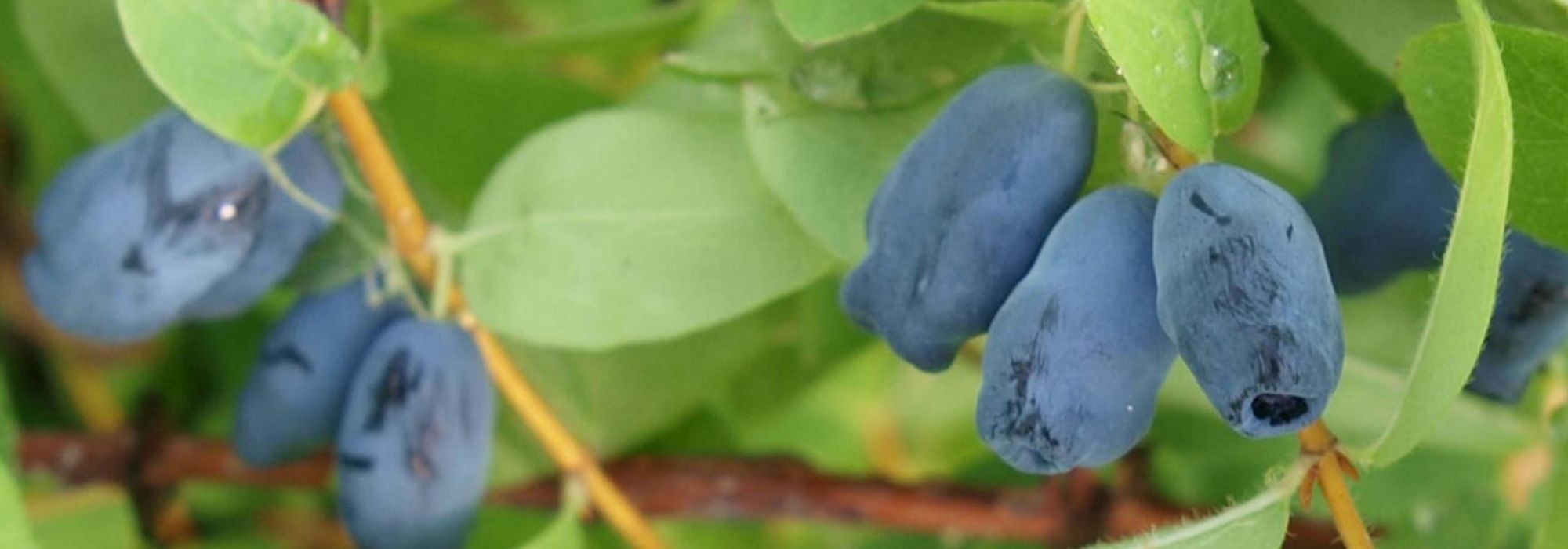
Blue honeysuckle, haskap: planting, cultivation, care
Contents
Berry of May in a nutshell
- Blue honeysuckle (Lonicera caerulea kamtschatica), also called mayberry or haskap, is a bush honeysuckle that produces edible berries
- It is one of the earliest small fruits of spring; berries are eaten fresh or used in jams or jellies
- The red flesh of blue honeysuckle fruits is said to be rich in vitamins C and B and to have antioxidant properties
- This extremely cold-hardy fruiting bush is planted in full sun and in fertile, moist soil low in lime
- Mayberry will fit equally well in a productive or flowering hedge, including in a small garden or in a large pot on a patio, and is easily propagated by cuttings
A word from our expert
Called also “May berry” or “blue honeyberry”, Lonicera caerulea kamtschatica is a honeysuckle with edible berries still little known in France. Yet its midnight-blue fruits with appearance and a delicious blueberry flavour deserve a place in our orchards and ornamental gardens!
Tangy, sweet, rich in vitamins C and B, the red flesh of the honeyberry bush has antioxidant and revitalising properties. A concentrate of health! Whatever the variety, May berries ‘Altaj’, ‘Tomishka’, ‘Duet’ or ‘Sweet Myberry’ are all fruit-bearing and extremely hardy.
This bush is very easy to grow in any fertile, well-drained, lime-free soil that remains fairly cool, as it hates drought. Once planted, simply water during dry spells!
It is used as a specimen, grouped in a bed, in a fruit hedge or in an orchard.
Fancy tasting the May berry? Treat yourself to a young plant, plant in autumn or spring for a harvest in May and June! And set off to discover the finest varieties of this edible honeysuckle ready to conquer our French gardens!
Description and botany
Botanical data
- Latin name Lonicera caerulea
- Family Caprifoliaceae
- Common name Blue honeysuckle, Honeyberry, Edible honeysuckle, Mayberry, Blue honeyberry, Haskap
- Flowering May–June
- Height 1 to 1.50 m
- Sun exposure sun, partial shade
- Soil type neutral, fertile and moist
- Hardiness -40°C
Edible honeysuckle, Latin Lonicera caerulea, more commonly called Mayberry, blue honeyberry or blue honeysuckle (honeyberry), is a fruit-bearing bush of family Caprifoliaceae, like honeysuckle.
Native to mountainous areas of Eastern Europe, particularly Siberia, it remains too rare in cultivation in our gardens. It is widely cultivated in Japan, where it is called “Haskap”, and in Québec, where it is known as “Honeyberry”.
Genus Lonicera comprises over 400 species of bushes and lianas with deciduous or evergreen foliage. Lonicera kamtschatica, also named Lonicera caerulea kamtschatica, is the only shrubby honeysuckle species commonly grown in our latitudes because it produces particularly tasty berries. It has given rise to several varieties such as ‘Duet’, ‘Sweet Myberry’, ‘Kalimka’ or ‘Morena’, which are more hardy, more compact or more productive.
This non-climbing honeysuckle forms a bush with a small, bushy, upright habit. Rather slow-growing, this shrub can reach 1.50 m in height with a spread of about 1.25 m.
On woody stems, blue honeyberry develops a fairly lush deciduous foliage. Leaves are opposite and simple, ovate to elongated, 3–8 cm long, and resemble honeysuckle leaves. Depending on variety, they range from dark green to light green, sometimes bluish-green, and are slightly waxy or softly hairy.
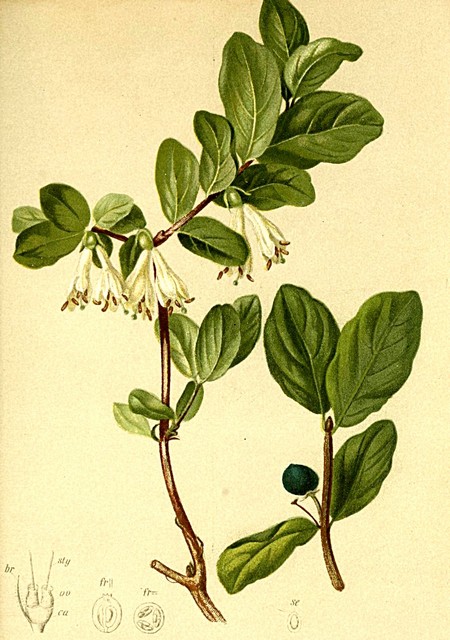
Lonicera caerulea – botanical illustration
Early, discreet flowering occurs from February–March to May. Numerous tubular flowers about 3 cm long, cream-white or pale yellow, open in pairs. They have two lips with rounded, pubescent petals from which stamens protrude and are slightly scented. This melliferous and nectariferous flowering attracts pollinating insects. To improve flower pollination and thus increase fruit set, it is advisable to plant several honeyberry bushes.
From May, hence vernacular name “Mayberries”, flowers transform into small oblong or cylindrical fruits 1–2 cm long, with a midnight-blue epidermis covered in bloom. In spring, blue honeysuckle is one of the very first small bushes to bear fruit, the honeyberries, well before raspberries or currants. Unlike climbing honeysuckle species that produce berries toxic to humans, berries of this honeysuckle are edible.
Fleshy and waxy, these appetising berries, hidden beneath foliage, resemble large blueberries of elongated shape or small plums. They sometimes give off a sweet honeyed scent (variety ‘Duet’). Their flesh, with an attractive reddish hue, has a tangy flavour reminiscent of kiwi, grape and blueberry.
Mayberries can be eaten fresh, cooked into jams, jellies, turned into juice or even dried.
Besides being delicious, these berries contain high concentrations of antioxidants and are rich in vitamins B and C as well as trace elements.
Very hardy down to -40°C, Lonicera kamtschatica is planted in sun across our regions. It dislikes very dry soils in summer and prefers soil that is rich, remains cool, well drained and free of lime.
It can be planted in ground in garden or orchard, to form low hedges, thicken back of borders or even grown in a pot on a terrace or balcony.
In Japan, Mayberries have been consumed for centuries for their beneficial properties; packed with antioxidants, they are reputed to promote longevity!
Read also
How to protect fruit trees from birds?Main species and varieties
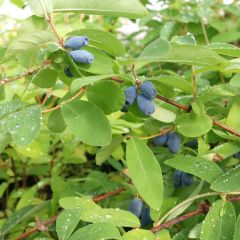
Lonicera kamtschatica - Honeyberry
- Flowering time April
- Height at maturity 1,20 m
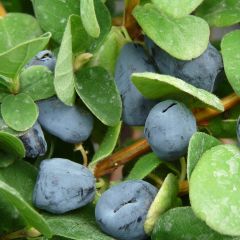
Lonicera caerulea kamtschatica Duet - Honeyberry
- Flowering time April
- Height at maturity 1,20 m
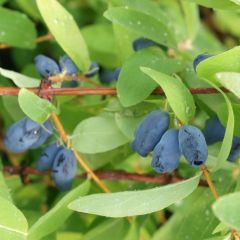
Lonicera kamtschatica Myberry Sweet - Honeyberry
- Flowering time April, May
- Height at maturity 1,30 m
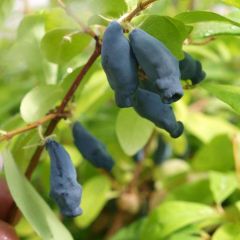
Lonicera kamtschatica Eisbär - Honeyberry
- Flowering time April
- Height at maturity 1,50 m
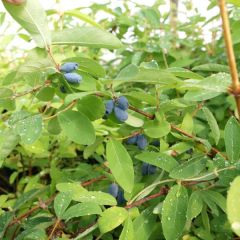
Lonicera kamtschatica Kalinka - Honeyberry
- Flowering time March to June
- Height at maturity 1,20 m
Discover other Honeyberry bush
View all →Available in 0 sizes
Available in 2 sizes
Available in 1 sizes
Available in 1 sizes
Available in 1 sizes
Available in 2 sizes
Available in 1 sizes
Available in 1 sizes
Available in 1 sizes
Available in 1 sizes
Planting
Where to plant honeyberry or May berry?
From Siberian origins, the honeyberry bush has retained excellent hardiness, able to withstand negative temperatures around -40°C without faltering, and even its flowers tolerate frosts down to -10°C. It will therefore adapt without problem to colder regions.
However, it does not like climates that are too hot or summer drought. The honeyberry will therefore appreciate full sun in northern areas and a part-shade exposure, less scorching, in the south.
It needs permanently fresh but humus-bearing and well-drained soil. It tolerates calcareous soils poorly: prefer planting in a pot in that case.
Its compact size allows varied uses, in garden as well as orchard, in a fruiting or country hedge, a flowerbed or a border along a path, and in a pot on a terrace.
When to plant May berry?
Planting honeyberry or Lonicera kamtchatica can be done year-round, favouring not-too-warm periods and avoiding severe frosts; in spring from February to April or in autumn from September to November.
How to plant May berry or edible honeysuckle?
In open ground
For good pollination and optimal fruit harvest, plant at least two different cultivars of honeyberry bushes close to each other (Aurélien explains everything on pollination of fruit trees). In a cluster, allow 4 plants per m2 spaced 0.40 to 0.60 m apart. For a hedge planting, leave 0.60 to 1 m between each plant. Plant in non-calcareous soil enriched with compost and leaf mould.
- Soak the rootball in a bucket just before planting
- Dig a hole about three times the height and width of the rootball (about 0.60 m)
- Loosen bottom of planting hole well, using a pick if necessary
- Backfill with a mix of potting compost and garden soil
- Place honeyberry in centre of hole, slightly raising the collar so that rootball is covered by 2 cm above soil level
- Add compost and leaf mould
- Water rootball well
- Backfill with a mix of garden soil and composted potting soil
- Firm soil well
- Water abundantly and mulch around the plant
More advice in our article “Planting a fruit hedge… with a twist!“
In a pot
Growing in a pot is perfectly possible. Choose a large, tall container with a pierced base (30 or 40 cm).
- Soak the rootball in a bucket before potting up
- Place a layer of clay pebbles at the bottom to promote drainage
- Spread part of a mix composed of potting compost, compost and leaf mould
- Water to moisten the substrate
- Place the honeyberry well in the centre
- Cover with the remaining mix
- Firm soil well
- Water again
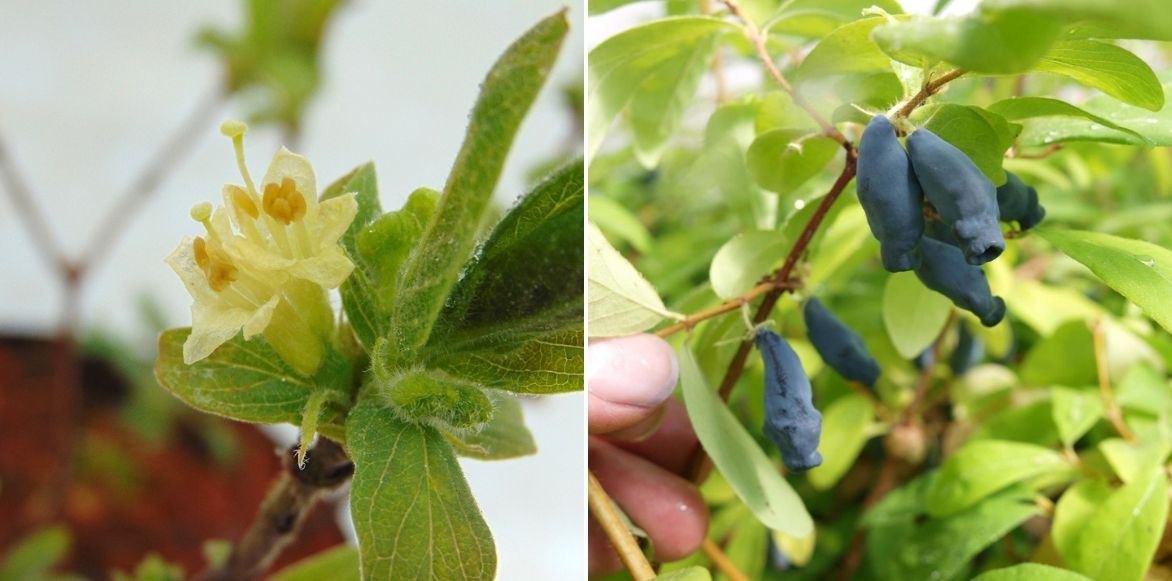
May berry : flower and fruits
Read also
Harvest and preserve May berriesMaintenance, pruning and care
Once well rooted, Camérisier or May berry requires little attention; it grows slowly but steadily provided you monitor water supply in summer. Ensure the soil stays cool enough during hot periods, because edible honeysuckle does not like drought. Water regularly and generously from spring to autumn but without excess: in ground or in a pot, the soil must never dry out completely between waterings. Apply a good mulch with a layer of dead leaves to keep the soil cool at the base.
Every spring, add compost or horn meal to promote vigorous growth.
Pruning is limited to maintenance pruning to balance branches or densify habit. Do not prune until after three years’ cultivation:
- After fruit harvest or in late winter, using pruning shears, remove dead wood, overly weak or diseased branches
- Shorten current-year shoots by cutting the ends at a slant
This fruit tree is not very susceptible to diseases and parasites, only sometimes affected by aphid attacks: regularly spray with water mixed with black soap in case of attack.
Haskap Harvest
Haskap berry harvest takes place between May and June, when berries are blue on the outside and their pulp is a deep dark red. One plant will yield 1 to 3 kg of haskap berries at most in good conditions, after about three to five years following planting.
Flesh of these small blue berries is slightly tangy and sweet and its taste lies between grape, rhubarb, plum, kiwi and blueberries. Once picked, fruits keep for only a short time (2 to 3 weeks in the fridge), but freeze very well.
Haskap berries can be eaten fresh like blueberries but also in jams, jellies, sorbets, juices or dried.
→ Find out more about harvest and preservation of haskap berries with Ingrid’s tutorial!
Propagation
Honeyberry or May berry is easily multiplied by propagation by cuttings of semi-ripe stems in summer.
How to take cuttings of May berry
- In August–September, take semi-ripe or semi-hardwood cuttings 10–20 cm long (i.e. stems that are turning from soft wood to hard wood)
- Remove lower leaves and leave a few leaves at the tip of the stems
- Plant cuttings in buckets in a light mixture of potting compost and river sand, kept slightly moist
- Overwinter them frost-free and water the cuttings regularly
- Plant out in ground or in a pot the following spring
Companion planting with blue honeysuckle
To create a productive hedge, include your Honeyberry bushes or Mayberries (at least two for better pollination) mixed with other small fruit trees such as raspberry plants, redcurrants, thornless blackberries, blueberries, lingonberries, amelanchier. They will form a vitamin-packed duo with Goji.

An idea for a fruit hedge pairing: redcurrant bush, honeyberry (or Mayberry), raspberry plants, blueberry bush and amelanchier
In a border, its white flowering and small blue fruits will stand out against a backdrop of spring-flowering bushes such as lilacs, mock-oranges, abelias, Pieris japonica or Kolkwitzia.
Floriferous perennials such as the Italian bugloss, columbines, campanulas, gauras, astrances or hardy geraniums in white/intense-blue harmonies and ground-cover perennials such as creeping bugles and heucheras will keep roots cool all summer.
A few nasturtium seeds sown at its base will naturally deter aphids from your honeyberry bushes.
Useful resources
- Adventurous, food-loving gardeners, discover all our unusual and exotic fruit trees!
- All our tips on planting, pruning and caring for our shrubby honeysuckles
- Discover our ideas: “Planting a fruit hedge… that stands out!“
- Our advice sheet: May berries: how to choose the right variety for your garden?
- Subscribe!
- Contents
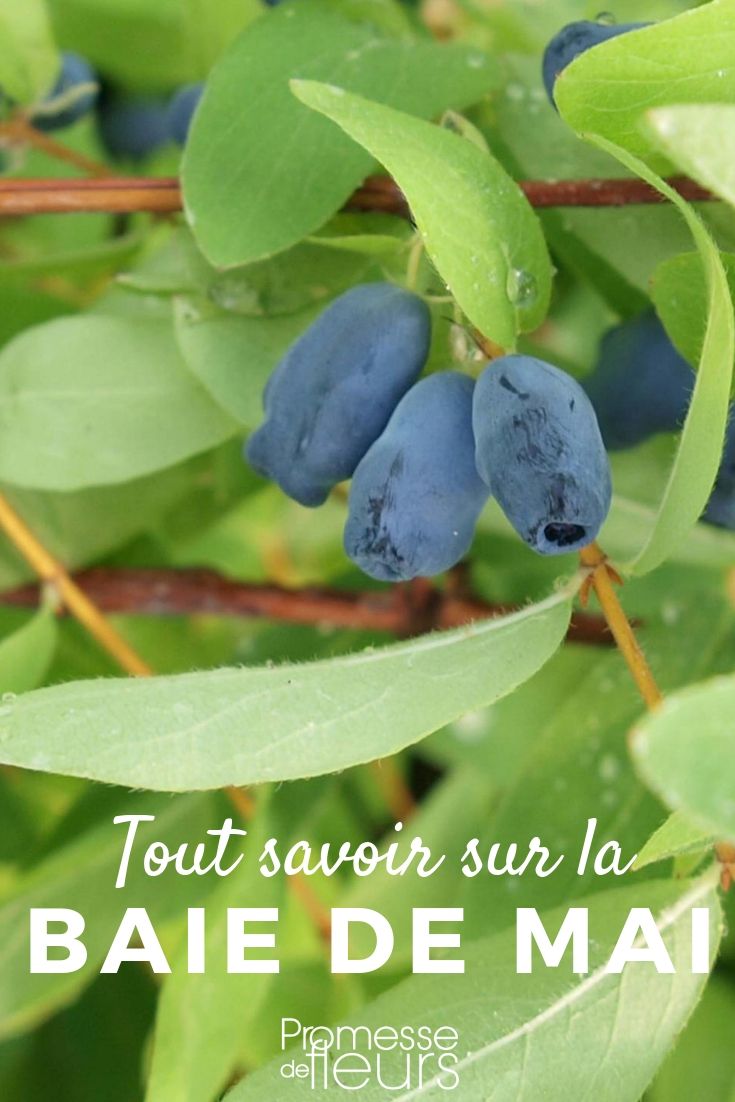


































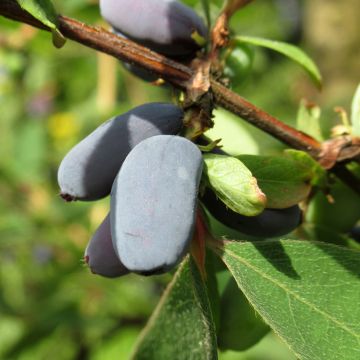
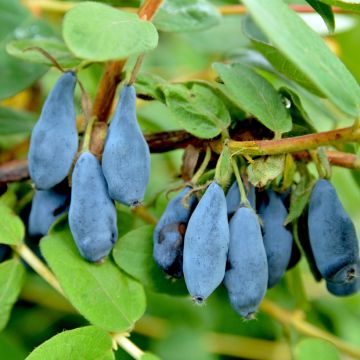
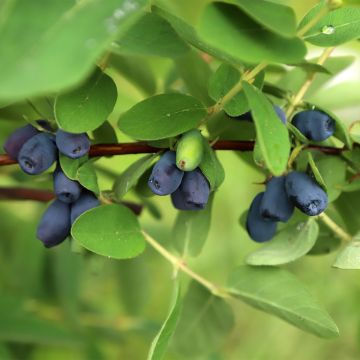
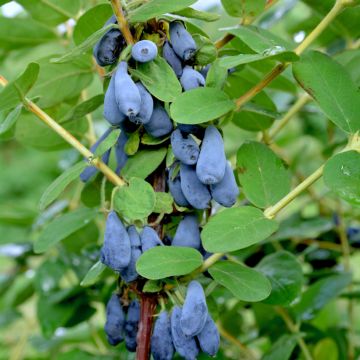
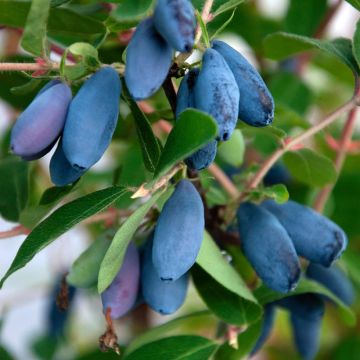
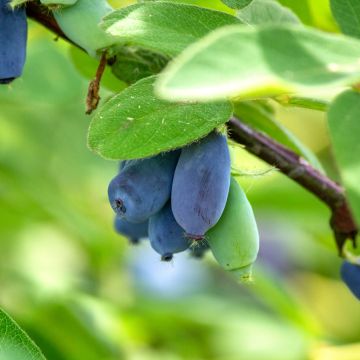
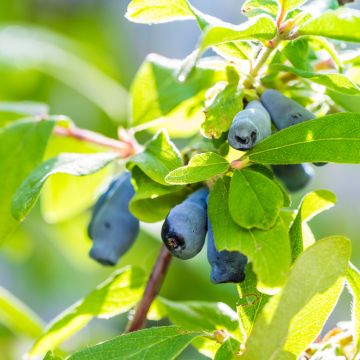
Comments